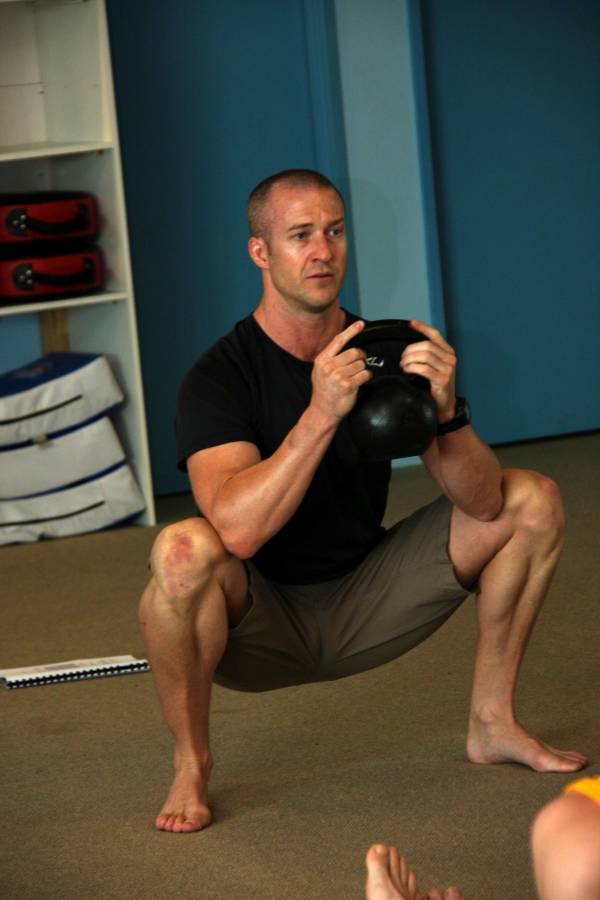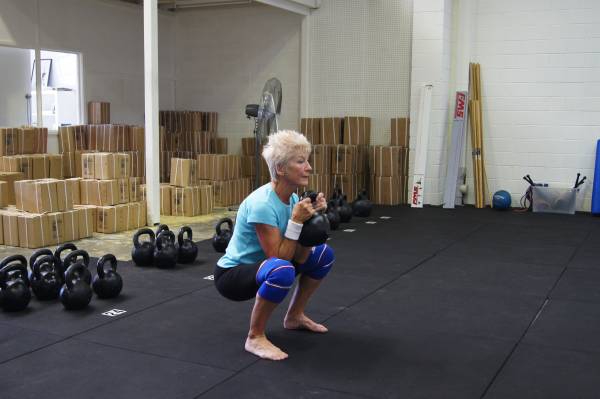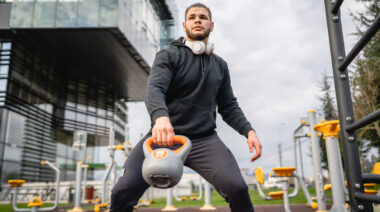If you’ve hung out in gyms for long enough you know one thing – the bench press may be the lift the bros all use to signify their dominance in the gym, but when it comes to displaying true alpha-male status nothing beats a big squat. The problem with squatting is that most people just can’t do it. There are various reasons why – from lack of mobility to lack of strength in the right areas to plain laziness (because heavy squats are brutal in a way that no other exercise can match).
In the RKC there are three versions of the squat, ranging from the goblet squat at the HKC, to the single kettlebell front squat (with the bell held single-handed on one side in the rack) for the RKC, and then the double kettlebell front squat for RKCII. The good part is that no matter which version you’re interested in the form is pretty much the same except for a few nuances with hand position. So, we’re going to start by teaching you a perfect goblet squat.
How to Goblet Squat
The first thing we’re going to need to do is set the stance up. You’ll need a training partner or video camera for this, not a mirror. Begin on the ground in a four-point stance. Your hands should be roughly under your shoulders, but more importantly begin with knees under hips and ankles dorsiflexed (as this mimics the foot position we’ll need for the squat). Your back should be flat here.
Start with a narrow stance – knees hip width apart with feet in line – and push your butt back from there. What we’re looking for is that your back stays flat and your knees travel back behind your hip crease. The squat depth we’re aiming for is hip crease below knee so this is the same thing, just rotated ninety degrees. Most people will find that this narrow position is difficult for them and their back will round or they won’t be able to get back far enough at all. Slightly widen your stance and try again. Eventually you’ll find a width that allows your back to stay flat and gives you enough range of motion to allow for a full squat.
Please note – if you can’t find a width that allows the back to remain flat and give you enough range then I’d suggest seeking out a CK-FMS before trying to go any further – you’re just not ready to squat deep at this point.
Once you’ve found the right foot position for your squat push yourself up from the ground into a standing position.
 The next thing to do is to grab a kettlebell. The best way to do this is not to slump over and try to curl it into place. A much better way is to hike pass as if you were starting to swing, and as the bell starts to come up instead of continuing the swing just pull it into place like a kettlebell upright row. Your hands will be gripping the sides of the handle and the bell will end up at the top of your chest. (Some people like to hold the bell right in front of their face and when they squat the handle ends up basically looking like a big moustache. If you ever want to make me laugh during training give yourself a kettlebell moustache, especially the ladies).
The next thing to do is to grab a kettlebell. The best way to do this is not to slump over and try to curl it into place. A much better way is to hike pass as if you were starting to swing, and as the bell starts to come up instead of continuing the swing just pull it into place like a kettlebell upright row. Your hands will be gripping the sides of the handle and the bell will end up at the top of your chest. (Some people like to hold the bell right in front of their face and when they squat the handle ends up basically looking like a big moustache. If you ever want to make me laugh during training give yourself a kettlebell moustache, especially the ladies).
To illustrate a point I want you to try to squat as deep as you can from this stance while keeping your knees as close together as possible. You can’t do it, can you? You know why? No space. The goblet squat is primarily a mobility exercise and we use it to reinforce the movement pattern before we add more load. One of Pavel’s magic “three S’s” for mobility is to “create space.” If we want to be more mobile we need to create space. That means we need to push the knees out to make that space. This helps the knees track the toes, but the main point is that we’re trying to sit our hips into the space between our feet.
As you squat down I want you to think about putting the point of your elbows into your vastus medialis – the teardrop shaped muscles on the insides of your knees. When you’re in that position – feet flat on the ground, elbows inside knees, and knees pushed out to make space and tracking over your feet – I want you to use your elbows against your knees as a fulcrum to pull your chest up and forward and really get your spine flat. Thinking about using this fulcrum to rotate the entire body so that it is more vertical and your hips are more in line with your feet than behind them is goo, too. The bottom body position should more resemble the overhead squat than a box squat.
 Now you’ve got a good feel for the bottom position we’re just going to add some breathing. At the top I want you to take a good sniff of air through your nose and into your belly. It’s important you breathe into the belly and not your chest – your chest isn’t going to stabilize your lower back. Holding that breath and tensing your stomach as if someone is going to kick you there, descend down to the same point as before – elbows inside knees, knees pushed out, hip crease below knee – once there give out a short exhalation or grunt (think of quickly saying “ha!”) and rise out of the squat, driving through your heels.
Now you’ve got a good feel for the bottom position we’re just going to add some breathing. At the top I want you to take a good sniff of air through your nose and into your belly. It’s important you breathe into the belly and not your chest – your chest isn’t going to stabilize your lower back. Holding that breath and tensing your stomach as if someone is going to kick you there, descend down to the same point as before – elbows inside knees, knees pushed out, hip crease below knee – once there give out a short exhalation or grunt (think of quickly saying “ha!”) and rise out of the squat, driving through your heels.
Squat Variations
The only difference between the RKC single bell front squat and the goblet squat is the position of the bell. You clean the bell into place and then squat holding it on one side. While the performance is the same, you will likely find a few things out about your ability to stabilize yourself. Many people who can goblet or double squat well cannot single bell squat well, and this is a sign you have some issues to sort out.
From there, the double front squat is the same again except you will clean two bells into place and squat while both remain in the rack. For many the limiting factor is abdominal strength, not leg strength. The double bell squat is more similar in feel to a Zercher squat and puts a lot of load on the trunk. Yet because of the hand position, it may be a better alternative than barbell front squats for those with wrist problems or who dislike the feel of Zercher squats.
Learn the six basics RKC exercises:
How to Do the Perfect Kettlebell Swing
How to Do the Perfect Kettlebell Clean






